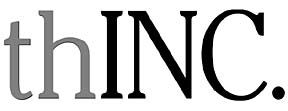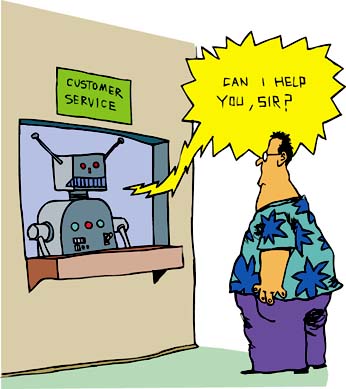

A forum for Hawaii's
business community to discuss
current events and issues
» Save us from help » Maui's tourism rebound
BACK TO TOP |
Save us from help
Customer service system
designers are badly in need
of a shot of empathy
There is hardly a service industry today that is not trying to get its customers to do more and more via the Web.
From airlines competing with travel agents to banks trying to reduce the number of human resources, the promises are similar. The cost savings from fast and efficient service will be passed along to the consumer in the way of lower prices.
Alongside that rhetoric, here's an example of the reality that goes along with a local organization's efforts to motivate just such behavior in the form of doing all your banking electronically.
A client of mine in Europe recently asked me if I'd prefer to have them send a check to cover my work or just deposit it electronically. Doing it electronically would cost them some moneys, but they were more than willing to do so because they so valued our relationship. A "no brainer" for me. Or so it seemed until my office manager noticed that our local bank, where we've been doing business for more than 25 years (the same one that is spending huge amounts of advertising money to motivate us to bank electronically) charged $25 to receive and process the electronic transfer.
During my next visit to the bank I explained my disappointment at what had happened. Response? A "robotic"; "That's our policy, sir." Then I asked what it would have cost me if I had deposited a check for that amount personally. Response? "It wouldn't have cost anything, sir." Followed by another wonderfully programmed robotic response [I was obviously not the first to ask these questions]: "But you would not have been able to draw on those funds for several working days."
Imagine that! For the mere sum of $25, I was able to draw upon funds sitting in the Bank of England immediately versus having to wait for several days.
This experience led me to dig through my files for an old Web story, a small portion of which follows.
What if bank customers issued the following statements? Henceforth, the authorized contact person at the bank is the only one with whom I shall deal. [Please note that a notary public must countersign copies of all of his/her medical history and financial details.] In due course, I will issue this person a PIN number, which will be 28 digits in length. This person may call me at anytime and their call will be answered by my automated voice service.
On the matter of costs the ongoing drive for greater efficiency comes at a cost, which you have always been quick to pass onto me. Let me repay your kindness by passing some costs back. Inquiries from the authorized contact will be billed at $5 per minute of my time spent in response. My new automated phone service runs at 75 cents per minute so you'd be advised to keep your inquiries brief and to the point. Regrettably, but again following your example, I must levy an establishment fee to cover setting up this new arrangement.
There is an important challenge underlying this all too familiar scenario.
Customer service people, it would appear, seldom use themselves as the guinea pigs for the systems they design. And even if they do test their own system, it is only a test to see if it works. That is not the same a having to use it day after day. Senior executives have VIP numbers that get them around their own systems. No pressing buttons and listening to Muzak for them. And I doubt if too many airline executives use their Web sites to get reservations or sit in one of the sardine cans called a seat when they do fly.
Customer service systems are becoming increasingly de-humanizing systems. The only way to humanize them is for the senior executives in the organizations that have them, and the people who design them, to have to use them day-in and day-out. Like the rest of us.
Empathy is the best form of service. As long as it doesn't come pre-recorded from a new button I can press.
Irwin Rubin is a Honolulu-based author and president of Temenos Inc., which specializes in executive leadership development and behavioral coaching, communication skill building training, and large system culture change. His column appears twice a month in the Honolulu Star Bulletin. Send questions and column suggestions to temenos@lava.net or visit temenosinc.com.
BACK TO TOP |
EXPLAINING THE ECONOMY
Maui tourism’s strong
2003 rebound leads to
questions about future
Maui's economy has enjoyed a 2003 snapback, led by the recovery of its visitor industry. Its tourism was hit harder in the wake of 9/11 than any other county in the state.
Interest rate related activity at the state level last year was the saving grace, making the 9/11 recession less serious than many forecasters originally thought. Yet even that wasn't enough to save Maui, which was hit hard by visitor industry job losses. Yet this year, there has been a broadly based snapback in Maui jobs. The county unemployment rate, with the exception of a slight uptick in 2001 associated with 9/11, has fallen from 7.5 percent in 1997 to only 3.7 percent in the first half of this year.
Tourism leader
The biggest reason for Maui's 2003 recovery has been its booming tourism summer, the best since 2000. The Valley Isle has continued to benefit from its longstanding upscale image and its lower dependence on weak Japanese tourism.Maui's visitor sector easily has led the state this year. In the first half, arrivals were up almost 7 percent, compared to big declines on Oahu and smaller ones on the Big Island and Kauai. Due to added flights directly to Maui this summer, total air seats were up almost 15 percent in the first half of the year.
Hotel occupancies are up, but overall statistics are deceiving. Some of the more popular properties report being sold out completely in some periods.
As on the other neighbor islands, Maui tourism is being affected by two emerging trends -- time-share and cruise ships. Opinions are divided across the economy on these two things:
>> Time-share visitors provide stability because they have paid already and come despite increasingly frequent one-time shocks to global tourism. We found that out after 9/11. Yet some hoteliers point out that they also take air seats away from independent tourists, provide lower tax revenues, and provide fewer jobs because of reduced services.>> As for cruise ships -- and Norwegian Cruise Lines will be adding two more the size of the Norwegian Star next year -- it's a similar mixed bag. Cruise passengers also take air seats coming to Hawaii, and may spend less retail and restaurant dollars. Still, they take advantage of many tourism activities during their short stay ashore, and many Maui activity operators report double-digit sales gains this year. Harbor infrastructure must also keep up to accommodate these big vessels, and their time at the dock can interfere with other uses, such as sugar loading.
Low interest rates
As elsewhere in Hawaii, one of the strongest areas of Maui strength in recent years has been construction, boosted by record low interest rates. Maui construction this year isn't running at quite the same pace as in the last several because there are fewer really big projects, but it's still very strong.New residential projects include 144 units at Maui Lani Phase 7, 184 two-acre lots at Wailuku Country Estates, and Makila Plantation Phase I upslope from Lahaina on the old Pioneer Mill sugar acreage.
Non-residential projects coming to completion this year include Kamehameha High School, the Lahaina Recreation Facility expansion, and Kaiser Medical Center at Mauna Lani. And on the tourism side, the Kaanapali Ocean Villas time-share project is beginning occupancy now.
Maui real estate sales and prices have increased over the years, sometimes with little relation to the underlying economic cycle. There has been a big run-up in both sales and prices recently.
Commercial land and real estate prices are not rising at the same rates as on the residential side, but vacancy rates are as tight as ever. Inventories are low due to previous absorption.
Kamaaina companies
Maui has long had two major kamaaina companies that have been big players in its development, retail, real estate and agricultural sectors. These days, one is expanding and one is not.Alexander & Baldwin on Maui continues to plan for:
>> A 140-room Courtyard by Marriott hotel in Kahului. (Maui has long needed a good business type hotel, and this can fill that need.)The other major Maui company, Maui Land and Pine, is exiting the retail business -- selling its share in Queen Kaahumanu Center and the Napili Plaza property. The company's real estate in Kapalua is doing well, but suffers from a lack of inventory. On the agriculture side, ML&P is continuing its transition from canned to fresh product, but is reducing its acreage in pine.>> A 179-acre light industrial project along the Hana Highway. (Demand for such a development is strong, and it is well located.)
>> A 150-lot single family residential subdivision in Haliimaile.
Agriculture
A&B's HC&S sugar operation remains a big player in Maui agriculture. Yields are quite good, and production this year will be about 219,000 tons, around the same as last year.Like the other remaining sugar plantation in Hawaii, HC&S is concentrating a small but growing part of its business on value-added sugar niche products. This allows a partial escape from the vagaries of the weather and the world commodity market.
Leroy Laney is a professor of economics and finance at Hawaii Pacific University. Reach him at lo9_laney@hotmail.com. This article is based on the annual economic survey of Maui that Laney conducts for First Hawaiian Bank.
To participate in the Think Inc. discussion, e-mail your comments to business@starbulletin.com; fax them to 529-4750; or mail them to Think Inc., Honolulu Star-Bulletin, 7 Waterfront Plaza, Suite 210, 500 Ala Moana, Honolulu, Hawaii 96813. Anonymous submissions will be discarded.
